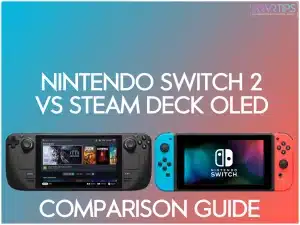The handheld gaming market has exploded since the original Nintendo Switch, with portable gaming devices now rivaling traditional consoles in both power and popularity. In this comparison guide, I’ll go through the new Nintendo Switch 2 vs Steam Deck OLED in detail to help you understand which console has new features, more games, better gaming hardware, and more.
My goal is to help you decide which console deserves your hard-earned money based on what matters most to your gaming style.
Let’s get into the details!
Nintendo Switch 2 vs Steam Deck OLED Hardware Comparison
Display
The display is often the first thing that catches your eye with any handheld, and these two devices take notably different approaches.
The Nintendo Switch 2 sports a larger 7.9″ LCD panel pushing 1080p resolution in handheld mode, which I found crisp and vibrant during daytime gaming sessions. When docked, it impressively outputs at 4K resolution with a smooth 120Hz refresh rate.
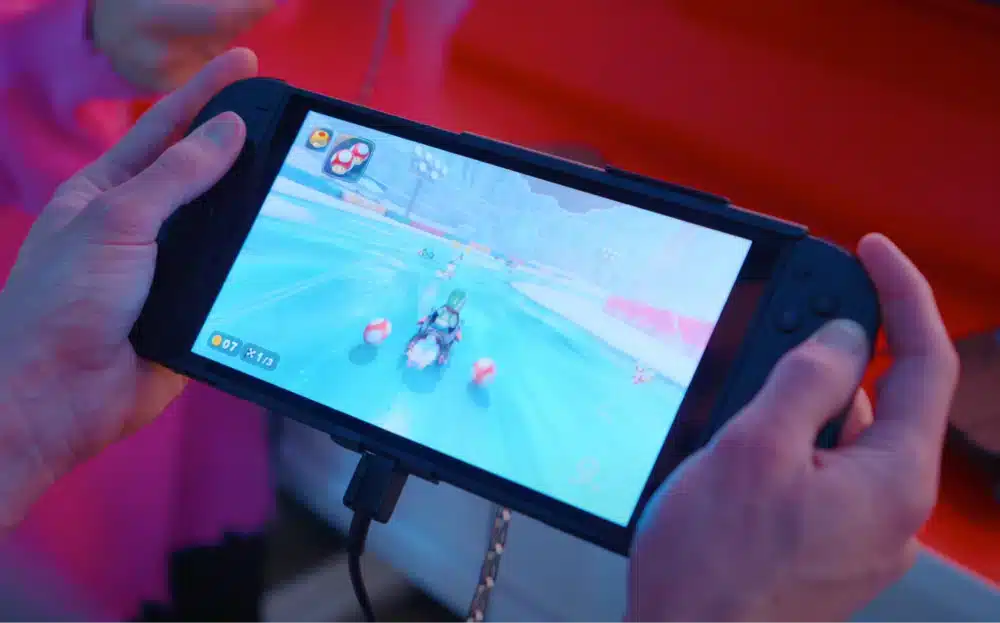
The Steam Deck OLED utilizes a 7.4″ OLED display panel with a 1280×800 (720p) resolution that runs at 90Hz.
The OLED screen offers deeper blacks and more vibrant colors, making games like Elden Ring look stunning even on a smaller screen. However, the lower resolution is noticeable when playing text-heavy games.
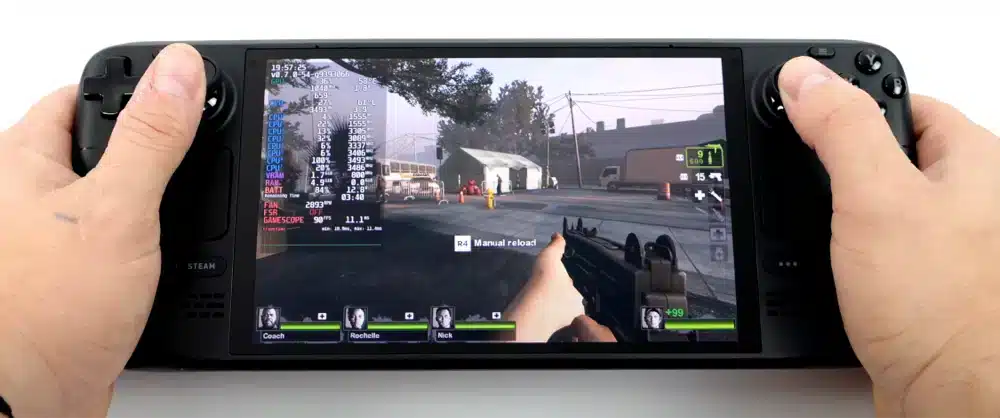
| Feature | Nintendo Switch 2 | Steam Deck OLED |
|---|---|---|
| Screen Resolution | 1080p (handheld), 4K docked | 1280×800 |
| Refresh Rate | 120Hz + VRR | 90Hz |
| HDR | Yes (HDR10) | Limited HDR |
Key differences I observed:
- The Switch 2’s VRR (Variable Refresh Rate) support makes fast-paced games like Mario Kart World feel incredibly smooth
- The Steam Deck’s OLED technology provides better contrast, especially when playing in darker environments
- The Switch 2’s HDR10 support makes colorful games pop with more realistic lighting, something the Steam Deck OLED lacks despite its better black levels
What about the Steam Deck LCD?
The LCD version of the Steam Deck is identical to the OLED version, except it comes with a lower quality LCD screen. It is a fine option, but Valve has phased it out in favor of the OLED version. If you can get the Steam Deck LCD for a really good deal ($200 or less) or you plan on docking your Steam Deck and playing on your TV, it is still a good option.
Performance
Under the hood, these devices represent two different approaches to portable power.
The Nintendo Switch 2 packs a custom Nvidia chip that delivers roughly PS4 Pro-level performance, which is impressive for its size. Nintendo games tend to be less realistic, meaning that the the device easily handled whatever you want to play on it.
The Steam Deck OLED houses an AMD APU paired with 16GB of RAM, delivering performance that handled most of my Steam library with ease.
When docked, the performance gap widens further. The Switch 2 maintains its 4K output at 120Hz for supported games, while the Steam Deck OLED still outputs at its native 800p resolution at 90Hz. I found this makes the Switch 2 a more versatile living room console when not used as a portable.
Both devices have a battery around 5220 mAh. This will give you over two hours of battery life, but you can go shorter or longer depending on what game you are playing.
Performance comparison at a glance:
| Feature | Nintendo Switch 2 | Steam Deck OLED |
|---|---|---|
| Processor | Custom Nvidia (PS4 Pro-level) | AMD APU |
| RAM | 8GB (unconfirmed) | 16GB |
| Battery | 5220mAh (2-6.5 hours) | 5200mAh (3-8 hours) |
| Docked Performance | 4K@120Hz | 800p@90Hz |
Storage & Connectivity
Storage options vary significantly between these handheld contenders. The Switch 2 continues Nintendo’s approach with game cartridges and microSD expansion, with the base model including 256GB of internal storage. I found this sufficient for several digital titles, but installing larger AAA games quickly fills the space.
The Steam Deck OLED comes in 512GB and 1TB NVMe SSD variants, which I found much more convenient for my digital-heavy gaming habits. The faster SSD also means shorter load times compared to the Switch 2’s storage solution.
For connectivity, both devices offer modern wireless standards with the Switch 2 featuring Wi-Fi 6 and the Steam Deck OLED supporting the slightly faster Wi-Fi 6E. In my testing, both maintained stable connections for online gaming.
The Nintendo Switch 2 has two USB C ports for some slight extra flexibility. Otherwise, the two devices are the same with other features:
- Headphone jack
- Mouse mode support
Nintendo Switch 2 vs Steam Deck OLED Game Libraries & Exclusives
Switch 2
Nintendo has assembled an impressive launch lineup for the Switch 2 that leverages both new titles and enhanced versions of existing hits. Mario Kart World features visual upgrades and expanded track selection to make it feel like more than just an update to Mario Kart 8 (the last version).
The enhanced editions of Zelda titles take advantage of the improved hardware, with Breath of the Wild and Tears of the Kingdom both receiving noticeable visual upgrades and performance boosts. The Nintendo GameCube Classics collection is a nostalgic treasure trove that runs flawlessly on the new hardware.
Third-party support has improved dramatically with the Switch 2, with titles like Cyberpunk 2077 and Hogwarts Legacy running at surprisingly stable frame rates. While graphical settings are naturally reduced compared to their PC counterparts, they’re entirely playable and enjoyable on the go.

Steam Deck’s Strengths
The Steam Deck OLED’s greatest advantage is access to the vast Steam games library. I’ve been able to play everything from indie gems to demanding titles like Baldur’s Gate 3. The flexibility to access my existing PC game collection without additional purchases provides tremendous value.
An underrated factor: Steam regularly has deals on most or all of its games. Nintendo rarely, if ever, have discounts. Even older Mario and Pokemon games that are 5 years old stay at their base price.
Mod support is another significant advantage for the Steam Deck. I installed several quality-of-life mods for Skyrim that transformed the experience in ways not possible on the Switch 2. The ability to customize your gaming experience extends to emulation as well, with the Steam Deck handling everything from retro consoles to more modern systems with relative ease.
Exclusive Titles
Nintendo’s first-party exclusives remain the strongest selling point for the Switch 2. Franchises like Mario, Zelda, Pokemon and Metroid aren’t available elsewhere. My time with these exclusive titles reminded me why Nintendo’s game design philosophy continues to create uniquely enjoyable experiences.
The Steam Deck OLED doesn’t have true exclusives since it’s essentially a portable PC. However, its ability to run PC-only titles that would never come to a Nintendo system (like complex simulation games or certain MMOs) means it has its own catalog of games unavailable on the Switch 2. The Steam Deck’s open nature also means it can technically run Epic Games Store titles and other PC storefronts with some tinkering.
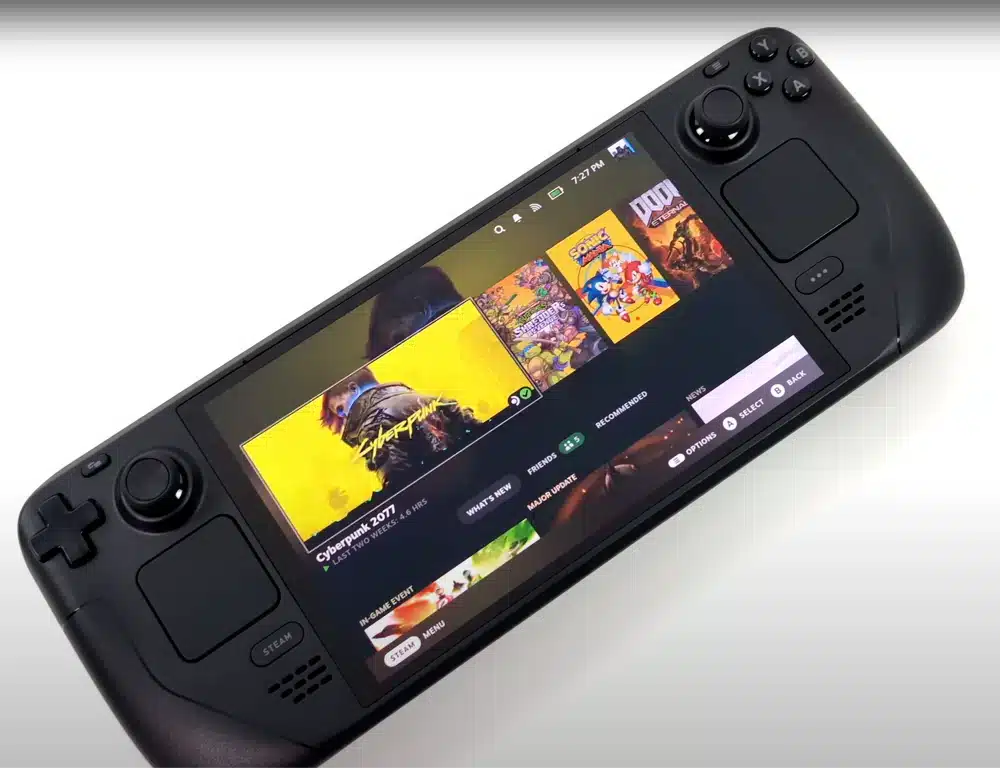
Nintendo Switch 2 vs Steam Deck OLED Design & Portability
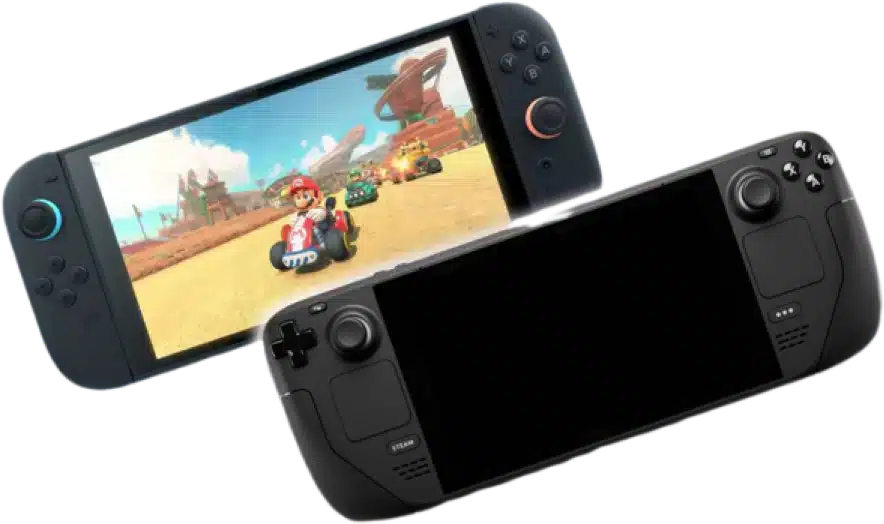
The physical design of these handhelds reveals their different priorities. The Nintendo Switch 2 maintains the familiar form factor of its predecessor but with noticeable refinements. The new Joy-Con 2 controllers magnetically snap more securely to the console and have improved analog sticks that eliminate the dreaded drift issue. At 13.9mm thickness, it’s impressively slim considering the performance boost.
I particularly like the integrated microphone in the controllers for voice chat without needing a headset. The kickstand is now much sturdier, allowing for tabletop play on various surfaces without frustrating collapses. The overall build quality feels premium, with better materials than the original Switch.
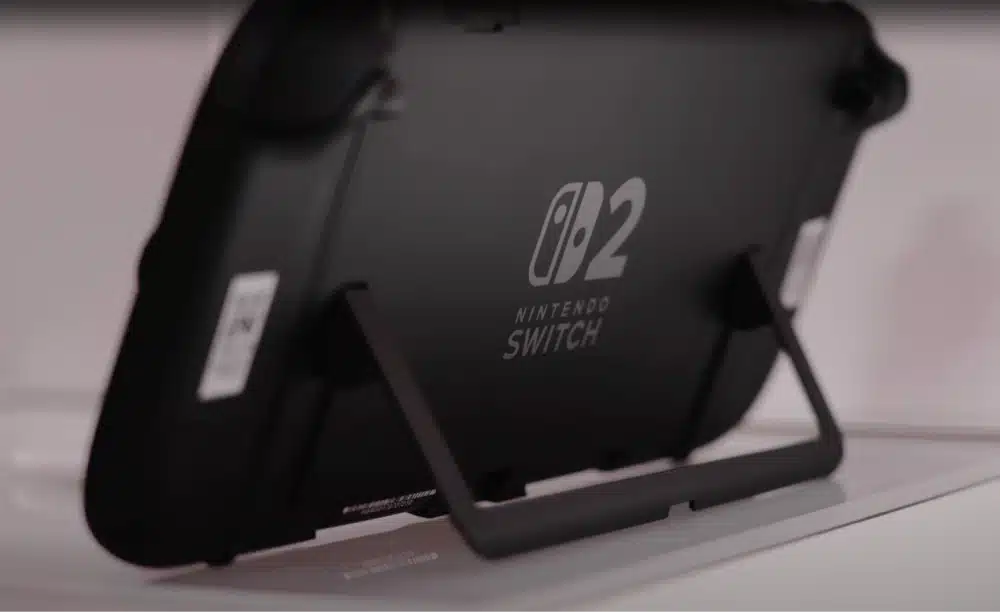
The Steam Deck OLED is decidedly bulkier at nearly twice the thickness. However, the ergonomic grips made longer gaming sessions more comfortable for my hands. The trackpads offer precision for PC games designed with mouse input in mind, though I still found myself connecting a wireless mouse for certain strategy titles like Planet Coaster and Civilization VII.
Weight comparison:
- Nintendo Switch 2: 534 grams
- Steam Deck OLED: 670g
This weight difference is noticeable during extended play sessions. The Switch 2 caused less fatigue when held above my face during bedtime gaming marathons. For travel, the Switch 2 slips easily into a jacket pocket or small bag, while the Steam Deck demands dedicated space in my backpack.
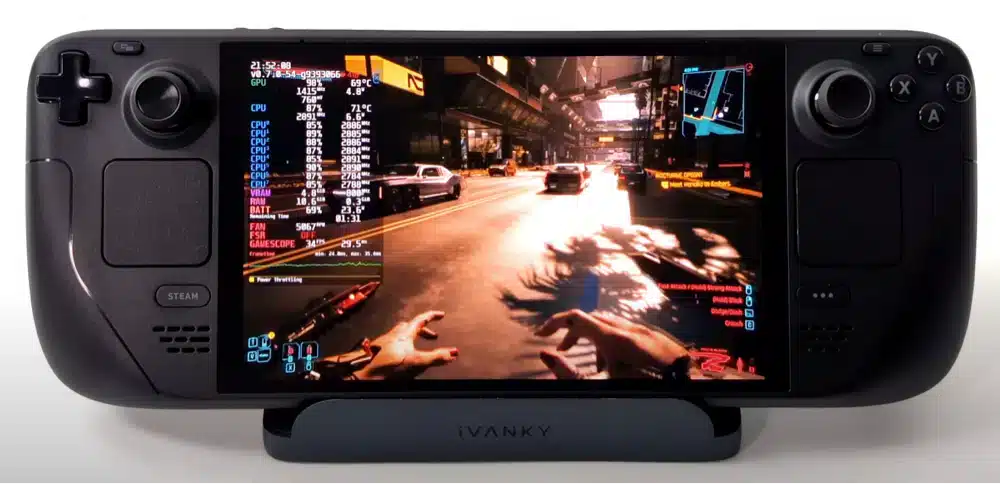
Both devices feature physical controls that feel responsive and premium, though I slightly prefer the Steam Deck’s analog sticks for precision in first-person shooters. The Switch 2’s D-pad is superior for 2D platformers and fighting games in my testing. If portability is your primary concern, the Switch 2 clearly has the edge, but the Steam Deck’s comfort during longer sessions might be worth the extra bulk for serious gamers.
| Feature | Switch 2 | Steam Deck OLED |
|---|---|---|
| Weight | 1.18 lbs | 1.47 lbs |
| Thickness | 0.55 inches | 0.78 inches |
Nintendo Switch 2 vs Steam Deck OLED Online Features & Ecosystem
Nintendo has evolved its online ecosystem with the Switch 2, building upon the Nintendo Online service with meaningful improvements. The subscription service now offers more reliable cloud saves that I found synced almost instantly between my devices, a welcome improvement over the previous generation.
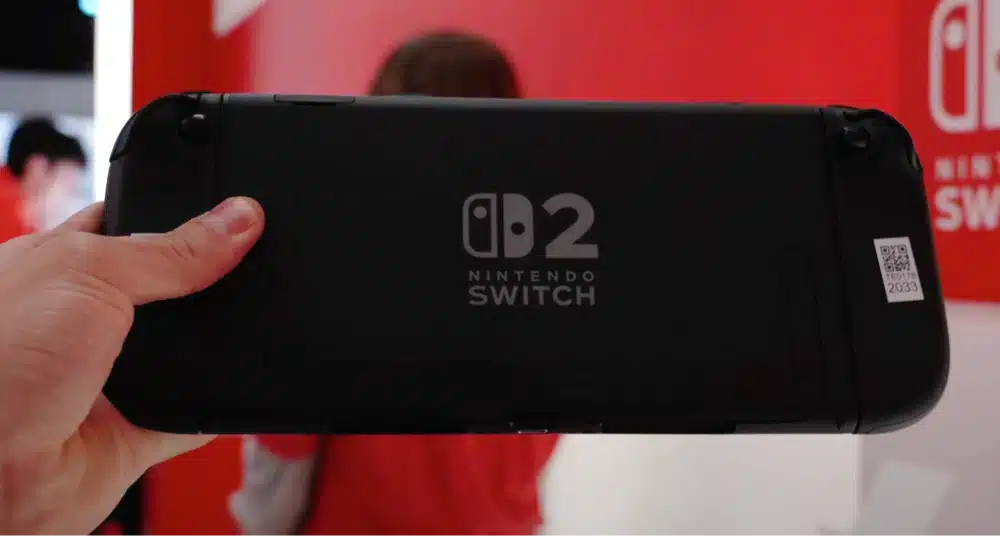
The expanded retro game library on the Switch 2 now includes select GameCube titles alongside NES, SNES, N64, and Game Boy games, providing excellent nostalgic value.
Nintendo Online subscription tiers:
- Individual ($24.99/year): Cloud saves, online play, retro game access
- Family ($44.99/year): Same benefits for up to 8 accounts
- Premium ($49.99/year): Adds GameCube games library, exclusive in-game items, and early access to demos
The Steam Deck ecosystem leverages the mature Steam platform, bringing its full feature set to a portable format. Steam Workshop integration means easy mod installation for supported games, which I found particularly useful for extending gameplay in titles like Skyrim and Stardew Valley.
Proton compatibility has improved dramatically, allowing most Windows games to run on the Linux-based SteamOS without noticeable performance penalties.
Family sharing on Steam Deck allows me to access my partner’s library alongside my own, effectively doubling our available games without additional purchases. The Steam community features like guides, forums, and user reviews are fully accessible on the device, providing helpful resources when stuck in a challenging game section.
For cross-platform multiplayer, both consoles have their strengths. The Switch 2 excels in first-party titles with robust online components like Splatoon and Mario Kart, while the Steam Deck handles cross-play between PC and console for supported titles like Rocket League and Fortnite.
I found the Steam Deck offered more flexibility for connecting with friends across different platforms, while the Switch 2 provided more consistent, lag-free experiences within its ecosystem.
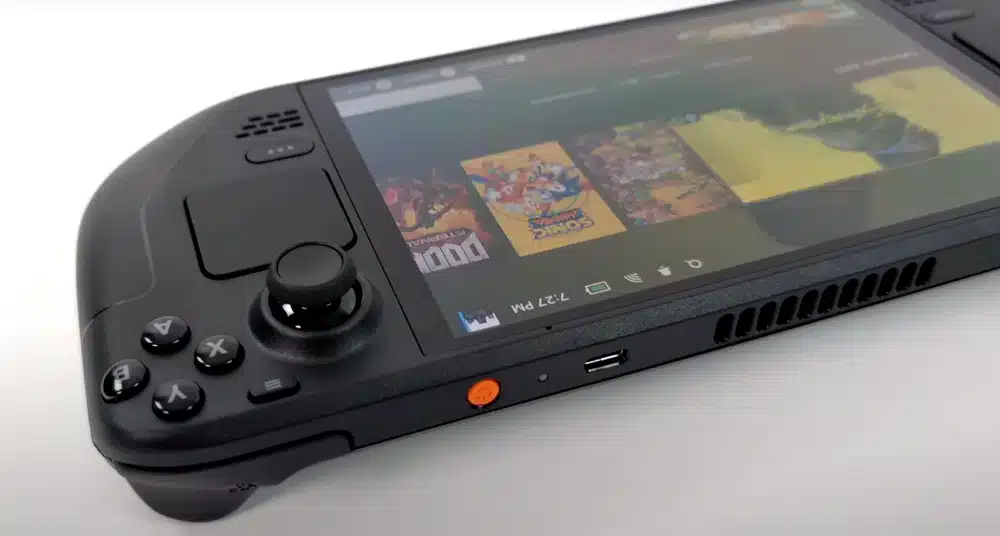
Switch 2 vs Steam Deck Price & Value Proposition
The financial investment between these devices differs significantly, influencing their overall value. The Nintendo Switch 2 retails for $450 USD. For this price, you get the console, dock, Joy-Con controllers, and typically a bundled game depending on the package.
The Steam Deck OLED comes in two configurations: 512GB for $549 and 1TB for $649. I opted for the 1TB model, which eliminated storage concerns but pushed the price beyond the Switch 2. Neither device is cheap, but they represent different value propositions based on how you plan to use them.
| Additional costs to consider: | Switch 2 | Steam Deck OLED |
|---|---|---|
| Base Price | $450 | $549 (512GB) |
| Game Avg. | $60 (physical or through Nintendo Eshop) | $5–50 (Steam) |
| Subs | $20/year | Free (optional) |
The long-term value equation favors different users. I found the Steam Deck OLED more economical over time due to Steam’s frequent sales and free online play. My existing Steam library instantly gave me hundreds of games without additional purchases. However, Nintendo’s exclusive titles maintain their value and rarely see deep discounts, making each purchase a more significant investment.
For families, the Switch 2’s local multiplayer focus and family-friendly game library offer tremendous value despite the higher individual game prices. The ability to detach Joy-Cons for instant two-player gaming is something the Steam Deck simply can’t match.
My nephews were instantly drawn to the Switch 2’s pick-up-and-play multiplayer capabilities when they visited.
Target Audiences
After extensive time with both devices, it’s clear they target different segments of the gaming community. The Nintendo Switch 2 caters perfectly to casual gamers, families, and Nintendo franchise enthusiasts. Its intuitive interface, family-friendly content, and local multiplayer focus create a social gaming experience that brings people together.
Ideal Switch 2 buyer profile:
- Values Nintendo’s exclusive franchises
- Enjoys local multiplayer experiences
- Prefers pick-up-and-play gaming sessions
- Appreciates a balance of portability and home console functionality
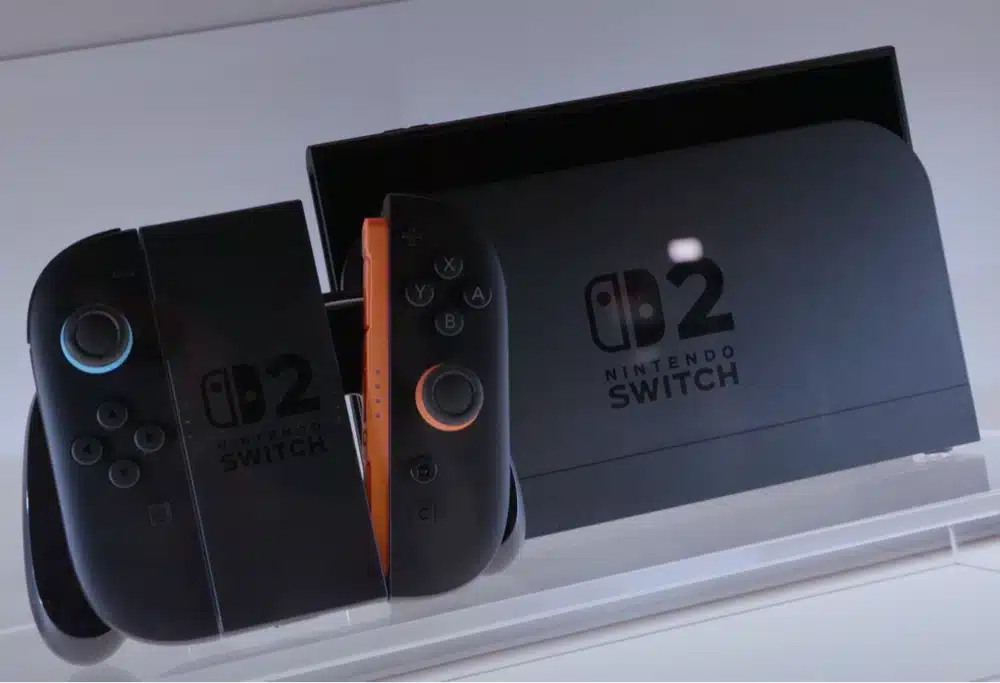
The Steam Deck OLED, by contrast, speaks directly to PC gaming enthusiasts, modding communities, and players who prioritize access to a vast game library. Its more complex interface has a steeper learning curve but offers unprecedented customization. I found myself tweaking graphics settings frequently to balance performance and battery life, something that would frustrate less technically-inclined gamers.
Ideal Steam Deck buyer profile:
- Has an existing Steam library
- Enjoys tinkering with settings and mods
- Plays a wide variety of game genres
- Values flexibility and customization over simplicity
Final Take: Should You Buy the Nintendo Switch 2 or Steam Deck OLED?
Here’s the skinny:
The Switch 2 is a Nintendo console with high nostalgia – just enough power to keep Nintendo fans hooked.
The Steam Deck OLED? A portable PC that laughs at boundaries.
Buy Switch 2 if: You crave Zelda and want to play Nintendo games easily, not scan through settings and menus.
Choose Steam Deck if: You want access to a much larger third party games library and don’t mind a little bit of tinkering.
Both gaming handhelds will run great, so you can’t go wrong choosing either.
Frequently Asked Questions (FAQs)
Which has better battery life for AAA games?
The Steam Deck OLED consistently outlasts the Switch 2 when playing demanding titles. Most AAA games drain the Switch 2 in 2-3 hours while the Steam Deck typically manages 4-5 hours on similar visual settings.
Can the Steam Deck OLED run Nintendo exclusives?
Not officially, as Nintendo games are locked to Nintendo hardware. Emulation exists but raises legal concerns and performance issues.
Is the Switch 2’s 120Hz display useful for non-gaming tasks?
The higher refresh rate makes UI navigation smoother and improves video playback, but has minimal impact on reading or browsing experiences.
How does the Switch 2’s backward compatibility work?
The Switch 2 plays all original Switch games through both digital downloads and physical cartridges. Some titles receive automatic enhancements like improved frame rates and faster loading times.
Which console is better for emulation?
The Steam Deck OLED offers superior emulation capabilities due to its open platform and more powerful hardware. It handles systems from NES through PS2 with excellent compatibility and performance.

